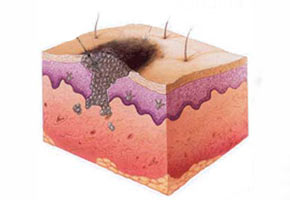

Group publishes article on the connection between the most serious type of skin cancer and the role of micro-RNA in epigenetic alterations that lead to tumor development
Group publishes article on the connection between the most serious type of skin cancer and the role of micro-RNA in epigenetic alterations that lead to tumor development
Group publishes article on the connection between the most serious type of skin cancer and the role of micro-RNA in epigenetic alterations that lead to tumor development

Group publishes article on the connection between the most serious type of skin cancer and the role of micro-RNA in epigenetic alterations that lead to tumor development
By Fábio de Castro
Agência FAPESP – In the last few years, a group of researchers at the Universidade Federal de São Paulo (Unifesp) has obtained significant results in advancing the knowledge regarding epigenetic alterations, oxidative stress and the development of tumors, – particularly melanoma, the most deadly form of skin cancer.
Epigenetics is the study of the portion of the genomes that does not encode proteins, but has a role in gene regulation. Oxidative stress is a result of the excess production of free radicals, which reduces the capacity of the antioxidant system found in every tissue.
The Unifesp group has been working on the cellular biology of cancer for nearly a decade under the leadership of Professor Miriam Galvonas Jasiulionis of the Department of Pharmacology. Their studies have used a transformation model of melanocytes – cells that produces skin pigment – in melanoma.
“The model consists of subjecting a line of non-tumorous melanocytes to conditions of sustained stress until they transform into melanoma. In doing so, we observed how transformation occurs solely from changing environmental conditions without introducing oncogenes,” explains Jasiulionis in talks with Agência FAPESP.
The main risk factor for melanoma is prolonged exposure to ultraviolet rays, which causes an oxidative stress condition. To this end, the researchers used a model in which a non-tumorous melanocyte is submitted to various cycles of stress and, acquires progressive cellular alterations.
The model uses both metastatic and non- metastatic melanoma, broadening the possibilities of further studies. The stress is provoked by the blockage of melanocyte’s cell adhesion.
“The model that we used allows for the study of a series of aspects, particularly epigenetic alterations, which are related to environmental changes. We know that chronic conditions of oxidative stress are related to the appearance of different pathologies. For this reason, the model could also be applied for other cases besides melanoma”, she notes.
In one of the aspects of the study, the researchers investigated the connection between melanoma and the role of micro-RNA (miRNA). These small molecules, which have two dozen nucleotides, do not code for proteins, but hybridize to messenger RNA (mRNA), perturbing its stability, interrupting the process of translation of the genetic information into protein and acting like epigenetic regulators.
With FAPESP funding under the Research Awards – Publication program, Jasiulionis and her doctoral student, Adriana Taveira da Cruz, co-authored a review article on the latest advances in the knowledge of the relationship between miRNA and melanoma, which was published in Dermatology Research and Practice.
Cruz’s doctoral project, “Identification of miRNAs involved in melanoma genesis and its possible epigenetic regulation of expression,” also received funding.
Jasiulionis coordinates the project “Epigenetic mechanisms as mediators of malignant transformation of melanocytes associated with sustained conditions of stress,” supported by FAPESP under the Regular Research Awards program.
“Although it is not the main focus of our group, the study on miRNA is important because they are an important control mechanism for expression, and for our research, understanding how epigenetic regulation of miRNA expression occurs is fundamental,” explains Jasiulionis.
In the article, researchers surveyed the existing miRNAs related to melanoma. According to Jasiulionis, because it impedes mRNA translation, miRNAs haves a central role in the formation of cancers.
“We know that miRNAs display alterations in expression in tumors, which prompted changes in different mRNAs. We are trying to identify not only miRNAs that are expressed in different stages of melanoma genesis, but also those that have altered expression because they have altered epigenetic marks,” he said.
In addition to being an important mechanism in the translational control of mRNA, the miRNAs could also be utilized as biomarkers and could become key in the development of new therapies against melanoma.
“Each miRNA has different target mRNA at the same time. And the same mRNA could target by different miRNAs. One of the prospects for the future is to identify a miRNA related to genes associated with tumor formations and develop antagonists from there on,” Jasiulionis.
According to the researcher, the melanoma that originates from the malignant transformation of melanocytes is extremely resistant to therapies when it enters the phase of metastasis.
“When it is diagnosed early, melanoma is easily treated. But, in the metastatic phase, it is extremely aggressive and does not respond to existing therapies. For this reason, it is important to identify the miRNAs involved in the process, not only for treatment, but also for identification of the tumor,” she said.
The article, miRNAs and Melanoma: How Are They Connected?, by Adriana Taveira da Cruz and Miriam Galvonas Jasiulionis, can be read by subscribers to Dermatology Research and Practice at www.hindawi.com/journals/drp/2012/528345/abs.
Republish
The Agency FAPESP licenses news via Creative Commons (CC-BY-NC-ND) so that they can be republished free of charge and in a simple way by other digital or printed vehicles. Agência FAPESP must be credited as the source of the content being republished and the name of the reporter (if any) must be attributed. Using the HMTL button below allows compliance with these rules, detailed in Digital Republishing Policy FAPESP.




